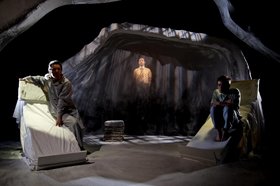"In Gaelic mythology there are tales of monstrous fish being washed up on shore. These would often transform themselves into other creatures or indeed people with magical powers. The sighting of one of these sea monsters was considered a portent.” (The Sign of the Whale, pg 28)
In 1977, a killer whale appears in Belfast Lough. Then it vanishes – but newspaper sub-editor Dermy believes it has found its way into the network of underground rivers beneath the city streets, and is swimming through the geography of war-torn Belfast. Recently blinded, and confined to a hospital room, Dermy escapes into an imaginary subterranean city where everything is topsy-turvy. With his fellow patient Tony, a teenage boy who has lost his sight in a nail-bomb attack, he spins stories of the magical city of Bestlaf. In this city Harmony and Merriweather make silk lingerie, the citizens are employed to farm the silkworms, and the streets are lined with mulberry bushes – “at times the perfume near chokes you”. The Pink Men honour their king, Willie the Pink, and “mince on the city streets wearing suggestive hats”. But Bestlaf has its grim double in Hellfast, and the characters are buffeted between these opposing concepts of their city’s present and future.
When the lights first come up, Dermy and Tony are on stage in pyjamas, their faces bruised and their eyes bloodied. The play is staged with a minimal set in shades of black, grey, and dirty white, recalling newspaper print, and therefore Dermy’s profession. Two piles of newspapers function as stools, but also as reminders of  the historical context for the action, and refer to Dermy’s obsessive and detailed knowledge of each of the events of the Troubles. The time and place of the action is further reinforced by the regular news reports on real events from 1977 which punctuate the action. A white arch, grimed in black and with newspapers visible at its base, suggests an underground cavern, as does the cave-like backdrop fitted with a scrim. Most of the news reports are delivered from behind the scrim, differentiating the present hospital room from the elsewhere of the media reports, and suggesting the characters’ isolation from the seeing world they formerly inhabited. In the space there are two dirty white structures, which function as hospital beds and chairs, as required. The performance uses this basic set to represent various locations – primarily the hospital room, but also Dermy’s home, the city streets, and Belfast’s Central Library.
the historical context for the action, and refer to Dermy’s obsessive and detailed knowledge of each of the events of the Troubles. The time and place of the action is further reinforced by the regular news reports on real events from 1977 which punctuate the action. A white arch, grimed in black and with newspapers visible at its base, suggests an underground cavern, as does the cave-like backdrop fitted with a scrim. Most of the news reports are delivered from behind the scrim, differentiating the present hospital room from the elsewhere of the media reports, and suggesting the characters’ isolation from the seeing world they formerly inhabited. In the space there are two dirty white structures, which function as hospital beds and chairs, as required. The performance uses this basic set to represent various locations – primarily the hospital room, but also Dermy’s home, the city streets, and Belfast’s Central Library.
There is a strong cast, with Miche Doherty in the part of Dermy, giving an excellent performance as the frustrated, disappointed sub-editor, the tragic-comic Micky Mumbles who wandered the streets muttering to himself and who delivers detailed monologues on the sectarian divisions within the city. John Travers plays Tony, who ultimately reveals himself as a bomber caught in his own blast, thereby setting up the conflict with Dermy’s world-weary pacifism. Mary Moulds and Michael Condron perform multiple minor roles with skill and humour.
The simple staging helps create a sense of magic and playfulness: to get from Belfast to Bestlaf, Dermy explains, you just need water – a puddle will take you there. The transition from Belfast to Bestlaf is performed by a small jump with each character shouting “Splash!” Other transitions are managed through changes in lighting which signal shifts in mood, time, or place - or through news reports which situate the action in a particular historical moment.
The main weakness in what is otherwise an engaging and enjoyable production is in one of the later scenes, when Dermy explains that he was blinded by a man in a balaclava, who found him wandering around the city centre in the night, searching for the whale. He delivers a long monologue denouncing all factions in the conflict: the Republican and Loyalist movements, and the British forces. Because he delivers the speech crouched, facing front, with a masked man standing behind him holding a gun at his head, the effect is of direct address to the audience. This lecture is both clichéd and unnecessary, since what Dermy says has already been communicated playfully and dramatically in the dialogue. The playwright needs to trust the audience’s ability to engage sympathetically with the work.
The final scenes return to the debate between Dermy – who sees in the whale the promise of wonder – and Tony, who can’t believe that a whale would come to Belfast. Overall, this is an entertaining and engaging piece of work that uses the metaphor of the whale to express the distance travelled since the 1970s, from the audience's post-Ceasefire perspective, and a consequent optimism for further positive change in Northern Ireland.
Lisa Fitzpatrick lectures in Drama at the University of Ulster.